Hi again everyone! So it was time to write my next blog post and as I was sitting and thinking and sitting and thinking and sitting (and getting yelled at for sitting too long) and thinking some more I was trying to decide what to write about. I could write about some of the animals here at the museum. Or some of my coworkers. Or about how one day I’ll have my own show on Animal Planet (it could happen!). But one of my favorite things that I enjoy writing about are exotic and strange species. Especially ones that are potentially lethal. 🙂 And I was thinking about how much everyone who comes to the museum seems to like the Lemurs. Now they’re cute and fun and all, but I want to tell you about some of the other animals that call Madagascar home and would live side by side with the Lemurs if they were living in the wild. They are a very diverse bunch and most cannot be found anywhere else on the planet.
To start, Madagascar is home to about half the world’s Chameleon species. Chameleons are small to mid size lizards which are famous for their color changing abilities. But, contrary to popular belief,the chameleon generally does not change it’s colors to match it’s surroundings but instead to convey emotions, defend it’s territory and communicate with others.
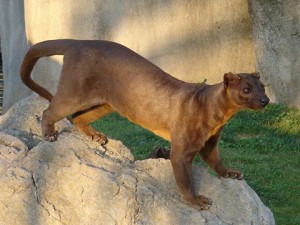
Madagascar also doesn’t have very many large mammalian predators. The biggest is an animal in the mongoose family called the Fossa. It looks like a cross between a cougar and a dog and was originally classified as a type of cat before being reclassed in the mongoose family. They grow to between 22-26lbs and will hunt and eat practically anything they can catch including insects, rodents, reptiles and Lemurs. They are active both in the trees and on the ground and have retractable claws to help them climb.
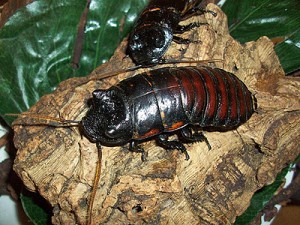
One very cool species that hails from Madagascar (and that we have on display here at the Museum) is the Madagascan Hissing Cockroach. These guys are very cool (yes I know- make all the “Mikey grew up in Queens” jokes you want!). They are one of the larger species of cockroaches getting around 2-4inches and are wingless. The males are easily discernible because they will actually grow “horns” on the front part of their carapace. The females will carry the egg case internally and release the young after they have hatched. The parents and offspring will usually remain in contact for extended periods of time and these roaches can live up to 5 years. These roaches also can quite loudly “hiss” in certain situations. Many insects can make hissing noises by rubbing together various body parts. The Hissing Cockroach is believed to be the only one that can do it by expelling gas through their breathing pores (spiracles). There are three main hisses. The Disturbance Hiss, the Female attracting hiss, and the Fighting hiss. These guys are occasionally kept as pets by people as they do not bite and eat only plant material so are easy to care for.
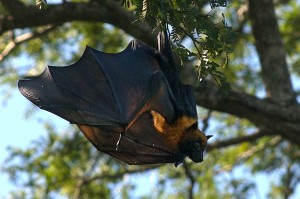
Another fun species, and one which CAN fly is the Madagascan Flying Fox. These large fruit bats live in colonies which number between 10 and 5,000 animals and will spend their nights feeding on the various fruits in their area. Or more accurately, the fruit juices which are squeezed from the fruit in the mouth during feeding. Also accidentally ingested are a large number of seeds during feeding. These seeds will pass through the digestive tract and be dispersed at various foraging sites, during flight or at roost. Studies have shown that some seeds actually will grow better after being passed through the bat’s digestive system. Because of its ability to travel long distances and its capability as a seed disperser and pollinator, the Flying Fox is widely believed to be a key species in perpetuating the health and diversity of the forest ecosystem. They also will eat flowers, nectar and leaves and some plants have even evolved to attract some nocturnal animals as pollinators.
Madagascar also is home to 258 species of birds, although only 115 of these are actually true natives of the Country. These species have a broad range, encompassing everything from owls to ducks, and pigeons to a family of birds called Couas which are types of Cuckoos. And up until a few hundred years ago, Madagascar was home to giant land birds. The largest was called Aepyornis or the “Elephant Bird” and stood 10 ft tall and weighed over half a ton. It was closely related to the ratites (emus and ostriches) of today. and is believed that these birds were quickly pushed to and over the brink of extinction due to over hunting by modern man.
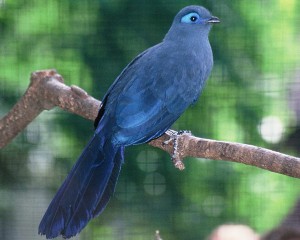
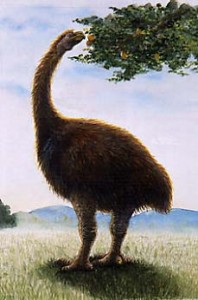
Okay, and now for my final creature that calls Madagascar home…I figured I would leave you with something cute and adorable to feel warm and fuzzy about when you’re done (No, not me. But thanks for thinking it!). So here it is… The Nile Crocodile! Yay! How huggable is that?! 🙂 Don’t you just feel the butterflies? I know what you’re thinking… “Mikey, aren’t the Nile crocodiles more of a mainland African species, primarily freshwater but with the occasional foray out into the salty sea?” (See? I knew that was what you were thinking!) And you would be right, but there are also Niles living in Madagascar too! How fun is that?! They generally like the Western and Southern Regions but there is also a population living in the cave system under the Ankarana nature reserve which exhibits unique behavior that other crocs don’t. In fact, studies are currently underway to see if these animals are possibly a subspecies of Nile, slightly divergent from the normal population of Crocodylus niloticus. The Nile crocodile generally preys on any wildlife it comes across, livestock and while man is not normally on it’s menu, it has a very opportunistic appetite. As well as the size, power, and intelligence to take down human prey. There is a real problem with poaching in Madagascar on the crocs, but at least for now, the population living within the caves seems to be thriving. They are the second largest species of crocodilian and can grow over 16 feet long, and weigh over 1,000 lbs. In working with many different types of crocs, I personally also feel that Niles are one of the smartest species as well. But then again, I’m partial- they are my favorites! 🙂
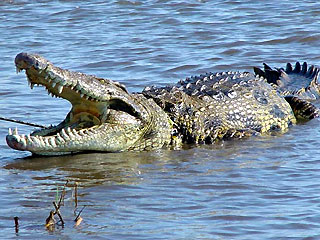
Well, that’s only a tiny glimpse of some of Madagascar’s species. If I wrote about all of them, I would be here for weeks, you’d get bored, my computer would short out and Sherry would be very unhappy with how little other work I would be getting done. Plus I’d get hungry and that is definitely not a good thing. Definitely, definitely not. Hope you found this interesting, I sure enjoyed writing it. There’s all kinds of other amazing things that live in Madagascar, from awesome little geckos, to little insectivorous mammals called tenrecs. By all means, as long as your online, check them out. Until next time, this post has been brought to you by the letters M & R, the number 007, and the color Orange. Have fun Kids! 🙂
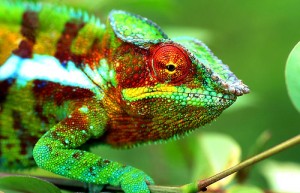
I love your posts, Mikey!
Um, so how do humans who actually have to live near Nile crocodiles manage the proximity? Is that part of the hunting problem, or is it just commercial? Because, while I understand the problem intellectually, if one of those guys were in my backyard, I’d be all for getting him hunted out!
Hey there Libby!
Thanks very much! I love all your great comments! And I’m so glad you enjoy reading the posts!
As for the crocs… the proximity is not part of the hunting problem- it’s really the skins. Crocodile skin is highly sought after and can go for a hefty price. So even if it’s a threatened species, it is still hunted. Sometimes even illegally, for its skin and other body parts.
You also asked about how people who live near crocs co-exist. All I can say is: Carefully. From what research I’ve done, it seems that the people try not to take unnecessary risks and are always very aware of what lives in the area with them. Mistakes can be fatal. I can’t speak from experience because there are no crocs wandering the means streets of Queens, mind you (and no, there are no Alligators in the sewers either!). But from what I’ve read it just seems that after centuries upon centuries of cohabitation, the crocs are just another part of life and the people deal with them just as they would other things in their lives. It’s just very intimidating to us possibly because we aren’t used to that lifestyle.
When, according to the fossil record, did the elephant bird live?
Hey Sherry,
Actually as far as the fossil record can tell the Aepyornis started out way back in the Pleistocene and survived until just a few hundred years ago. Most accounts say into the the 1700’s actually. Although there are a few reports and unsubstantiated claims of evidence from the 1800’s as well. Either way, they are sadly gone now, and it’s in the very recent past. Missed them by that much! 🙁